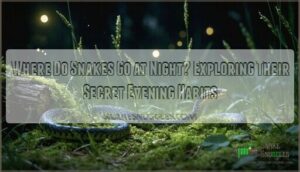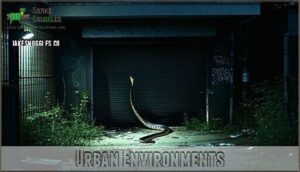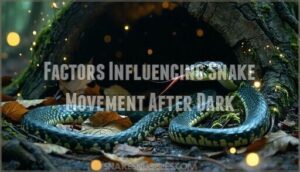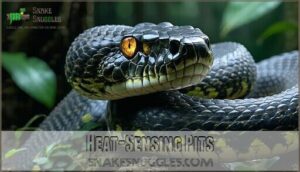This site is supported by our readers. We may earn a commission, at no cost to you, if you purchase through links.

Depending on the species, some tuck themselves into burrows, under rocks, or inside logs to rest and avoid predators.
Others take advantage of the cool, quiet hours to hunt, especially if they’re nocturnal.
They slither through grass, soil, or even urban nooks, using their keen senses to detect heat and scent.
In warmer months, you might see them more active at night to avoid the daytime heat.
Snakes are masters of staying out of sight, but if you’re curious, nighttime is when many of their secrets unfold.
Table Of Contents
- Key Takeaways
- Where Do Snakes Go at Night?
- Nocturnal Vs. Diurnal Snake Behavior
- Common Nighttime Habitats for Snakes
- Factors Influencing Snake Movement After Dark
- Seasonal Variations in Nighttime Snake Activity
- Snake Species With Nocturnal Tendencies
- Adapting to Darkness: Snake Sensory Abilities
- Coexisting With Nocturnal Snakes: Safety Tips
- Frequently Asked Questions (FAQs)
- Where do snakes hide at night?
- Do snakes come out at night?
- Where do snakes sleep at night?
- What do snakes do at night?
- Are nocturnal snakes active at night?
- Where do snakes eat at night?
- Do snakes wander around at night?
- What time of night are snakes most active?
- How do you know if a snake is around?
- Where do snakes go to sleep at night?
- Conclusion
Key Takeaways
- Snakes hide in safe, cool spots like under rocks, logs, or in burrows to avoid predators and regulate their body temperature at night.
- Nocturnal snakes actively hunt prey like rodents and insects, using heat-sensing pits and their forked tongues to navigate the dark.
- Urban snakes seek shelter in basements, garages, or garden debris, often near potential food sources.
- Most snakes are busiest during twilight hours, from just after sunset to early morning, when it’s cooler and predators are less active.
Where Do Snakes Go at Night?
At night, snakes find hidden, cozy spots to sleep or stay safe from predators.
They’ll slip under rocks, into hollow logs, or cozy up in tall grass—places where they won’t stand out. These Nocturnal Snake Dens also help them regulate their temperature.
In cities, you might encounter them in Urban Snake Havens like basements, garages, or sheds.
Snake nocturnal behavior varies. Some stick to snake sleeping habits, while others hunt.
Their snake nighttime activity often involves slithering along Snake Migration Routes to track prey like small mammals or insects, their preferred Nighttime Snake Diet. Some species even use thermal sensing organs to locate warm-blooded prey.
Knowing where snakes sleep or hide helps you spot them and understand their patterns—making coexistence safer and easier for everyone.
Nocturnal Vs. Diurnal Snake Behavior
No, not all snakes are nocturnal. In fact, their activity depends on several factors like species variation, habitat selection, and evolutionary advantages.
Some snakes thrive in the darkness, using special senses to hunt at night, while others bask in the sunlight, resting once the day cools. This mix of nocturnal and diurnal behavior helps snakes adapt and survive across different ecosystems.
Temperature influence plays a huge role. Cold-blooded snakes can’t generate their own heat, so their movements depend on the weather. On hot days, they’ll hide to avoid overheating, but at night, when temperatures drop, many emerge.
Their hunting strategies involve either ambush or stalking.
Here’s a quick look at snake behavior:
| Behavior | Nocturnal Snakes | Diurnal Snakes |
|---|---|---|
| Active Time | Night | Day |
| Key Habitat | Cool, dark areas | Warm, sunny spots |
| Hunting Focus | Small nocturnal prey | Active daytime prey |
| Temperature Preference | Cooler temperatures | Warmer temperatures |
| Typical Examples | Rattlesnakes, boas | Coachwhips, garters |
Understanding these patterns helps you coexist safely with these fascinating creatures!
Common Nighttime Habitats for Snakes
At night, snakes seek out cool, hidden spots like under rocks, logs, or thick brush to stay safe and regulate their body temperature.
Some even explore urban areas, sheltering near buildings, in garden debris, or under porches where prey might be nearby, and this behavior helps them stay close to potential food sources while also finding safe locations.
Natural Shelters
When darkness falls, snakes retreat to natural shelters, like rock shelters and log havens, to rest or stay hidden from predators.
Their nighttime routines include slipping into burrow systems or underground dens.
Dense foliage cover provides perfect spots for safety and temperature control.
These snake hiding places also play a part in their hunting and energy conservation during cooler nights, ensuring their overall well-being and safety through natural means.
To guarantee their comfort and safety, consider appropriate substrate selection in their habitat.
Urban Environments
Adapting to city life, snakes find nighttime shelter in urban snake habitats like garages, basements, and crawl spaces, often seeking warmth.
Urban snake diets thrive near light sources that attract prey. They play a crucial role in controlling rodent populations within the city.
To keep them away, consider these tips:
- Seal gaps in walls or doors.
- Clear clutter, like wood piles or debris.
- Install barriers, such as snake-proof fencing.
Factors Influencing Snake Movement After Dark
At night, snakes move for two main reasons: to hunt and to mate. Their activity depends on factors like temperature, food availability, and the need to find a partner.
Hunting and Feeding Habits
As the sun sets, snake nocturnal hunting kicks in, showcasing their skills.
They rely on prey detection and adjust tactics to the situation.
Here’s how different species secure their meals:
- Ambush predators stay hidden, waiting for prey to wander close.
- Active foragers slither through terrain, using their sharp senses to track food.
- Constrictors wrap around their catch to subdue it.
- Venomous snakes deliver precise bites, relying on venom to immobilize.
Their food sources and digestion process depend on what’s available, whether small mammals, birds, or even amphibians.
Mating Behaviors
During the mating season, nighttime becomes a stage for fascinating snake behavior patterns.
Nocturnal snake species follow pheromone signals to locate mates. Males often engage in mate competition, displaying combat dances to secure territory.
Courtship rituals, essential for reproductive success, occur throughout their seasonal breeding. Temperature also plays a key role, as snakes require the right climate for these activities.
Snakes also use their Jacobson’s organ to detect chemical cues. Their nighttime routine reflects the importance of reproductive cycles in their snake habitat at night.
Seasonal Variations in Nighttime Snake Activity
Snakes adapt their behavior to changing seasons, shifting activity levels to suit their environment.
Here’s how snake behavior patterns vary:
- Spring Emergence: Snakes get moving after hibernation, seeking warmth and food.
- Summer Peak: Nights buzz with activity, especially full moon evenings when nocturnal snake species hunt.
- Autumn Decline: Activity slows as they prepare for winter dormancy.
- Winter Dormancy: Most snakes rest in hibernacula, conserving energy until temperatures rise.
Understanding snake seasons helps you avoid surprises during nighttime walks.
Some species use heat-sensing pit organs to hunt effectively in the dark.
Snake Species With Nocturnal Tendencies
Some snake species, like the night snake (Hypsiglena torquata), have evolved impressive nocturnal behavior, emerging after dark to hunt in rocky areas, deserts, and chaparral.
Venomous night hunters, such as prairie rattlesnakes, use heat-sensing pits to track prey in total darkness.
Arboreal night snakes descend from trees, while aquatic night snakes hunt near water.
Snake habitats reflect their needs, from shaded crevices to dense vegetation, and understanding their nocturnal behavior helps with Nocturnal Snake ID and supports snake conservation efforts alongside safety precautions.
Adapting to Darkness: Snake Sensory Abilities
You’d be amazed at how well snakes navigate the dark using their unique senses.
Snakes thrive in darkness, skillfully using heat-sensing pits and forked tongues to track prey and navigate their surroundings.
From heat-sensing pits to their forked tongues, they’re equipped with tools that help them find prey and stay aware of their surroundings, utilizing complete concepts such as these to thrive.
Heat-Sensing Pits
At night, certain snakes, like pit vipers, rely on heat-sensing pits to navigate darkness.
Located between their eyes and nostrils, these pits act like mini thermal cameras, detecting even the slightest heat changes from nearby prey.
This infrared detection range helps them zero in on warm-blooded animals, even in pitch black.
- Uncover prey hiding spots with unparalleled accuracy.
- Sense warmth to adjust their thermoregulation.
- Utilize Pit Organ Function for seamless heat signature analysis during their nighttime routines.
Forked Tongue and Vomeronasal Organ
You’ve probably seen a snake’s forked tongue flicking rapidly—it’s not just a quirky move.
That flick collects scent particles, with the vomeronasal organ processing chemical signals like a super-precise GPS.
Snakes excel at hunting in the dark, boosting prey detection accuracy.
| Feature | Purpose | Function | Advantage | Importance |
|---|---|---|---|---|
| Forked tongue | Scent particle collection | Detects prey, threats | Enhances nocturnal behaviors | Key for survival |
| Vomeronasal organ | Chemical signal processing | Analyzes scents | Pinpoints prey location | Improves hunting precision |
Coexisting With Nocturnal Snakes: Safety Tips
When you’re outdoors at night, staying safe around snakes means being mindful of your surroundings and watching where you step.
At home, simple precautions like sealing gaps and keeping the yard tidy can help keep these slithery visitors away, which is crucial for maintaining a safe environment, and being mindful is key to preventing unwanted encounters.
Outdoor Precautions
When heading outdoors after dark, staying safe means being prepared. Snakes are most active and hunting prey at night, while avoiding predators. They love hiding in tall grass or under leaf piles, so steer clear of such spots.
Wear sturdy boots and long pants to protect your legs from bites. For enhanced protection, consider investing in specialized snake footwear. Keep a flashlight handy for nighttime visibility, especially at dusk or dawn.
Stay alert, scan trails often, and watch where you step.
- Check trails carefully for movement or snake shelters.
- Wear proper boots for safe footing in uncertain areas.
- Carry a flashlight for better visibility after dusk.
- Avoid overgrown areas where snakes might hide.
- Know emergency contacts for first aid.
Home Protection Measures
Protecting your home from nocturnal snake visitors takes a little preparation.
Here’s how to keep them out:
- Seal Entryways: Block cracks and gaps in doors, walls, and windows.
- Yard Maintenance: Keep vegetation trimmed and remove wood piles, clutter, or debris.
- Snakeproof Fence: Install snake fencing around your home to keep snakes out.
- Natural Snake Repellents: Use cinnamon or clove oil as a deterrent against unwanted guests.
These fences can be purchased from various retailers.
These steps guarantee a safer home and minimize snake nighttime safety risks!
Frequently Asked Questions (FAQs)
Where do snakes hide at night?
Imagine lifting a rock or a log—surprise, that’s where snakes hide.
They also curl up in tall grass, burrows, or under debris, staying cool, hunting prey, and avoiding predators.
Snakes love dark, shady spots.
Do snakes come out at night?
Yes, many snakes come out at night, especially nocturnal species.
They hunt for food, seek mates, or cool down.
You’ll often find them in shaded areas, tall grass, or near rocks and water.
Where do snakes sleep at night?
Snakes sleep in safe, hidden spots like under rocks, logs, or in burrows.
They prefer cool, dark places, avoiding predators and extreme temperatures.
Some even rest in trees or tucked into dense grass or brush.
What do snakes do at night?
Most snakes hunt, search, and explore at night.
They’re seeking food like rodents, tracking mates through scent trails, and moving between shelters.
You’ll find them most active during cooler evening hours when they can regulate their body temperature effectively.
Are nocturnal snakes active at night?
Most nocturnal snakes are indeed active after dark. They hunt prey, search for mates, and move between hiding spots when temperatures cool down and predators are less active.
Where do snakes eat at night?
Most species hunt wherever they find prey – under rocks, logs, near water sources, or around buildings.
They’ll eat rodents, frogs, insects, and small mammals in these same hiding spots where they spend their nights.
Do snakes wander around at night?
Picture a midnight snake disco where slithering partygoers cruise the neighborhood.
Yes, you’ll find these nocturnal wanderers actively hunting and exploring after dark.
They’re searching for food, mates, and comfortable spots to regulate their body temperature, which is a key aspect of their nocturnal lifestyle.
What time of night are snakes most active?
You’ll find most snakes are busiest during twilight hours – just after sunset and before sunrise.
They prefer these cooler temperatures for hunting, typically between 7-10 PM and 4-6 AM when it’s not too hot or cold.
How do you know if a snake is around?
You’ll spot snake tracks in mud, see ripples in water, or hear rustling sounds in bushes.
Look for shed skin, droppings, or disturbed vegetation.
Their musky scent often lingers nearby too.
Where do snakes go to sleep at night?
Imagine snakes curling up like tiny ropes in hidden havens.
At night, they tuck into cool, shaded spots under logs, rocks, or burrows.
Some nestle in trees, brush piles, or cracks, perfectly blending into their surroundings.
Conclusion
Ever wonder where snakes go at night? They’re out finding cozy spots or stealthily hunting their next meal.
By knowing their habits—like using burrows, logs, or urban hideouts—you can appreciate how they thrive in the dark. Some snakes are nocturnal hunters, using heat-sensing pits and sharp tongues to navigate.
Whether slithering through forests or your backyard, they stay hidden yet active. So, next time you’re outdoors, remember: nighttime is when snakes reveal their secrets.
- http://wildliferemovalusa.com/snakenight.html
- https://mynatureguard.com/blog/where-do-snakes-hide-in-a-house
- https://www.chameleonforums.com/threads/question-where-would-a-snake-hide.26903
- https://rattlesnakesolutions.com/snakeblog/arizona-snakes/when-to-snakes-go-to-sleep
- https://critterstop.com/post/are-snakes-nocturnal















